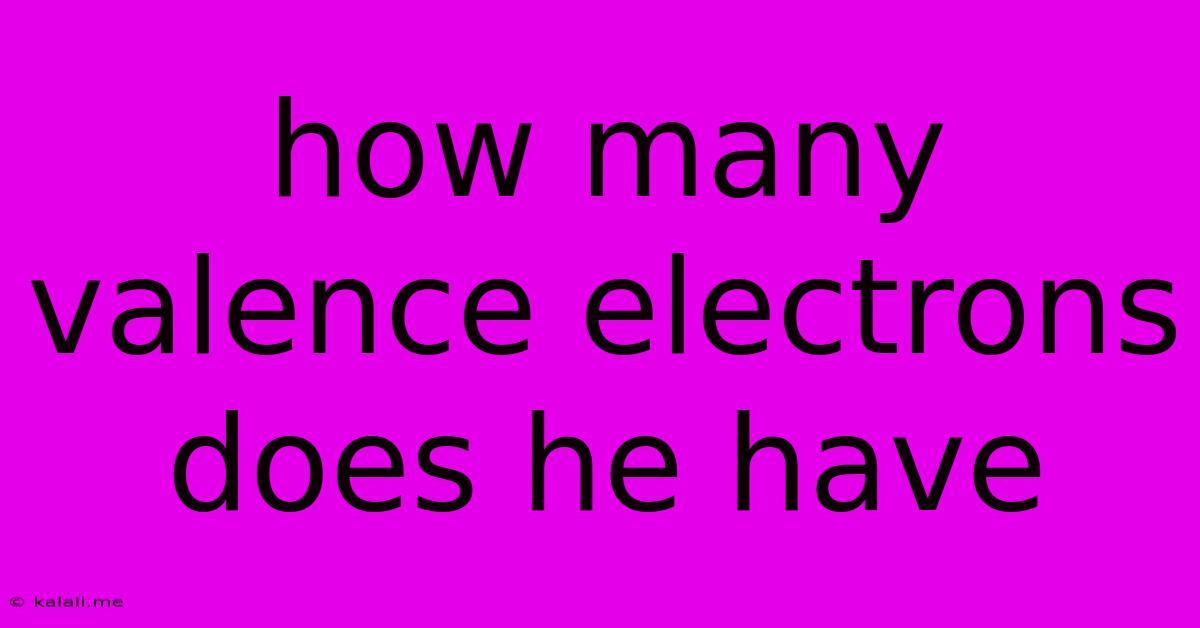How Many Valence Electrons Does He Have
Kalali
Jun 06, 2025 · 3 min read

Table of Contents
How Many Valence Electrons Does He Have? Understanding Valence Electrons in Helium
This article will explore the question: "How many valence electrons does helium have?" We'll delve into what valence electrons are, why they're important, and specifically determine the number of valence electrons present in a helium atom. This is a fundamental concept in chemistry, crucial for understanding atomic bonding and chemical reactivity.
Helium, a noble gas with the atomic symbol He and atomic number 2, is known for its inertness. This inertness is directly related to its electron configuration and, specifically, its valence electrons. Understanding this connection is key to unlocking a deeper understanding of chemical behavior.
What are Valence Electrons?
Valence electrons are the electrons located in the outermost shell, or energy level, of an atom. These electrons are the most loosely bound to the nucleus and are therefore the most likely to participate in chemical bonding with other atoms. The number of valence electrons an atom possesses significantly influences its chemical properties, determining how it will interact with other atoms to form molecules and compounds. Atoms strive to achieve a stable electron configuration, often by gaining, losing, or sharing valence electrons to obtain a full outer shell—a state of low energy and high stability.
Determining Helium's Valence Electrons
Helium's atomic number is 2, meaning it has two protons in its nucleus and, in a neutral atom, two electrons orbiting the nucleus. These electrons fill the atom's first energy level, also known as the 1s subshell. The 1s subshell can hold a maximum of two electrons.
Therefore, helium's electron configuration is 1s². Since all two of its electrons are in the outermost shell (the only shell in this case), helium has two valence electrons.
Helium's Inertness and Full Valence Shell
The significance of helium having two valence electrons lies in its relationship to the octet rule, although helium is an exception. The octet rule states that atoms tend to gain, lose, or share electrons in order to have eight electrons in their outermost shell. While this rule generally applies to most elements, helium's full outermost shell with two electrons makes it exceptionally stable. This complete outermost shell explains helium's inertness – its unwillingness to readily form chemical bonds with other atoms.
Implications and Further Exploration
Understanding valence electrons, and especially the unique case of helium, is foundational to numerous chemistry concepts:
- Chemical Bonding: The number of valence electrons directly dictates how an atom will bond with other atoms (ionic, covalent, or metallic bonding).
- Reactivity: Atoms with incomplete valence shells are generally more reactive than those with complete valence shells.
- Periodicity: The periodic table is organized based on the number of valence electrons, reflecting the recurring patterns of chemical properties.
Helium's stable electron configuration makes it a unique and important element, widely used in various applications, from cryogenics to medical imaging, due to its inertness and low boiling point. The fact that it possesses two valence electrons in a full outer shell is the key to understanding its behavior and its importance in both scientific research and practical applications.
Latest Posts
Latest Posts
-
The Impact The Character Has Vs Appearance
Jun 07, 2025
-
How To Get Rid Of Rats In My Yard
Jun 07, 2025
-
Can I Back Feed Electricity From Generator
Jun 07, 2025
-
Is Gluten Free Kosher For Passover
Jun 07, 2025
-
How To Prevent Dogs From Digging In Yard
Jun 07, 2025
Related Post
Thank you for visiting our website which covers about How Many Valence Electrons Does He Have . We hope the information provided has been useful to you. Feel free to contact us if you have any questions or need further assistance. See you next time and don't miss to bookmark.